
Machine Learning
- Categories Machine Learning, Emerging Trends
Hello.There is lots of buzz around Machine Learning now days. We will explain what is Machine Learning and its key concepts here.
Most of the traditional automated machines or robots around us are typically programmed to do set things. For example ATM machines, self-service checkout counters at grocery markets, robots which can perform surgeries and save lives, Industrial machines and space rover going to Mars.
These all are based upon set of predefined business rules. Like the traditional machines shown below.
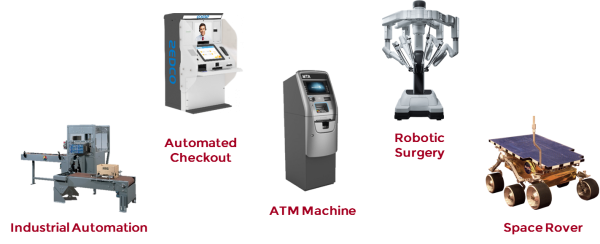
Traditional Machines
Unlike humans who learn from their experiences, if there is a new rule which needs to be processed, these machines will need software update.
So what is Machine Learning?
It is a subset of artificial intelligence.
It is mainly concerned with the development of algorithms which allow a computer to learn from the data, improve performance from experiences, and predict things without being explicitly programmed.
How is it different from Traditional Programming?
In traditional program a programmer adds new rules.
However in machine learning, the machine learns and writes its own rules. The algorithms adapt in response to new data and experiences to improve efficiency over time.
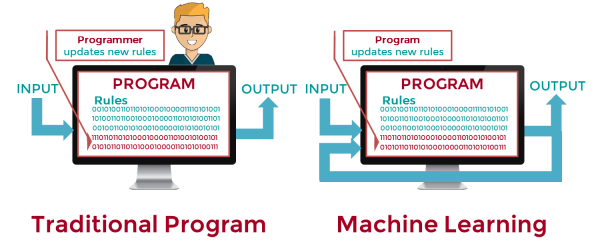
Machine Learning
Examples of machine learning
Examples of machine learning are self-driven cars like Tesla, Recommendation algorithms of Amazon, Netflix, Google, Spotify etc. Amazon Alexa and Apple Siri.
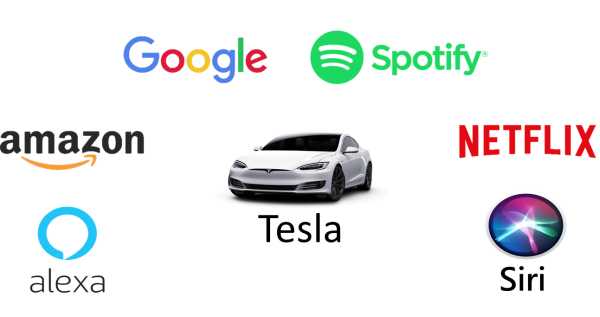
Examples of machine learning
History of Machine Learning
- 1952 – IBM developed the first program to play checkers.
- 1957 – 1st Artificial Neural Network for computers was made.
- 1958 – FICO introduced its first credit scoring system.
- 1959 – The term machine learning was coined by Arthur Samuel.
- 1967 – Nearest neighbour algorithm was written for basic pattern recognition.
- 1979 – Stanford cart navigated and avoided obstacles on its own.
- 1985 – Nettalk learned to pronounce words.
- 1992 – AT&T deployed first automated speech recognition.
- 1997 – IBM Deep Blue managed to beat world chess champion.
- 2010 – Google Brain used Neural Networks to detect human face in images.
- 2011 – AT&T deployed Natural language understanding in IVR systems.
- 2014 – Facebook developed deepface to recognize individuals on photo.
- 2016 – Google AlphaGo beats Go champion.
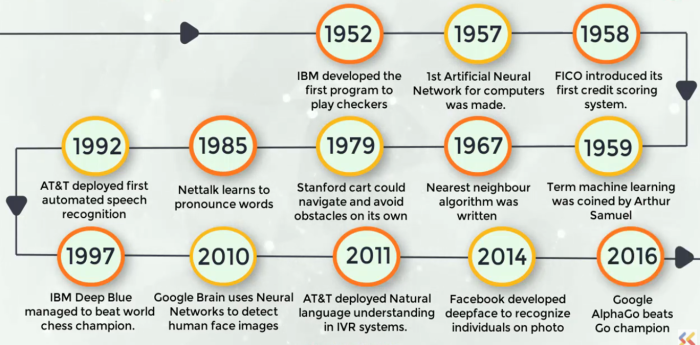
History of Machine Learning
Types Of Machine Learning
At a broad level, machine learning approach can be classified into three types:
- Supervised learning
- Unsupervised learning
- Reinforcement learning
- Supervised learning
- In Supervised learning the computer is presented with example inputs and their desired outputs, given by an expert or historical data, and their goal is to learn a general rule that maps inputs to outputs.
- The models used are sub-categorized as either a regression or classification model.
- In regression models, the output is continuous, for example Linear Regression, and Decision Tree.
- In classification model the output is discrete. For E.g. Support Vector Machine, and Naïve Bayes etc.
- It is most commonly used in Fraud detection, Weather, Market Forecasting, Disease Diagnostics etc.
- Unsupervised Learning
- In unsupervised learning, no output is given to the algorithm, leaving it on its own to find structure and to draw inferences and find patterns from input data.
- Two main methods used in unsupervised learning include clustering and dimensionality reduction.
- In clustering you do grouping of data points .
- Some examples are K-means clustering, and density based clustering.
- In Dimensionality reduction we reduce the number of random variables under consideration.
- Some such models are Principal Component Analysis, Gaussian Mixture Model.
- This mode of learning is used mostly for Data Visualization, Target Marketing or Recommendation Systems by doing customer segmentation.
- Reinforcement learning
- In Reinforcement learning, a computer program interacts with a dynamic environment in which it must perform a certain goal (such as driving a vehicle or playing a game against an opponent).
- As it navigates its problem space, the program is provided feedback that’s analogous to rewards, which it tries to maximise.
- Common models used here are Markovian iterative value, Q Learning and Evolutionary Genetic Algorithm.
- These are used in Gaming, Skill development via simulation, Robot Navigation etc,
- Deep learning:
- Many of the ML models are not feasible for large data sets.
- That’s where another subset of ML, Deep Learning comes into the picture.
- In Deep learning, artificial neural networks or algorithms inspired by the human brain are used.
- Some common algorithms of deep learning are Convolution Neural Network, Recurrant Neural Network, Auto Encoder etc.
- They are used in AI for Speech and Image recognition and for Natural Language Processing.
- Machine learning is an iterative process.
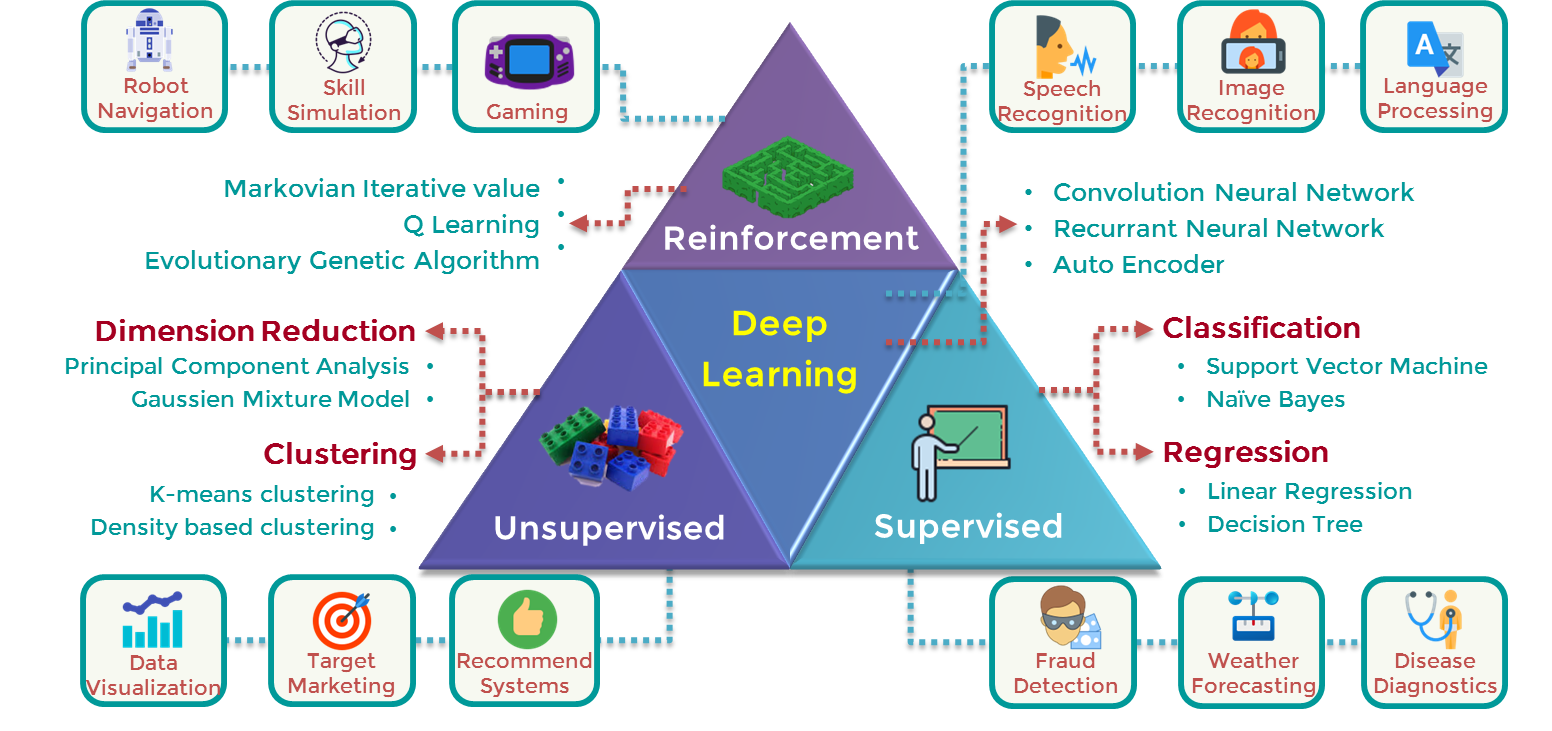
Types Of Machine Learning
What are the Steps in Machine Learning?
- Gathering data:
- First is Gathering data. In this we identify the source, quantity and quality of data.
- The more the data, the more accurate the prediction.
- Pre-processing data:
- In this we clean and convert raw data into a useable format.
- Here we remove duplicate data, invalid data, fill missing values, and extract features.
- The data is divided into multiple smaller data sets to be used further.
- Building the model:
- Here we select the machine learning algorithms such as Classification, Regression, Cluster Analysis, Association, etc.
- and then build the model using prepared data, and evaluate the model.
- Train the model:
- We use datasets to train the model using various machine learning algorithms.
- Training a model is required so that it can understand the various patterns, rules, and features.
- Test the model:
- Once our machine learning model has been trained on a given dataset, then we test the model.
- In this step, we check for the accuracy of our model by providing a test dataset to it.
- Deploy the model:
- Next we deploy the model in the real world system.

Steps in Machine Learning
Application of Machine Learning
- E-commerce
- E-commerce sites are using machine learning based product recommendation systems like Amazon, Flipkart along with Spotify, Netflix etc.
- Based upon your browsing history, they automatically recommend similar products.
- Social Media
- Social Media uses Sentiment Analysis to gauge consumer response to a specific product or a marketing initiative.
- It is also used to filter SPAM in the e-mails.
- Virtual Bots
- Another application of Machine Learning is building Virtual Bots which can be trained to handle customer queries and manage simple tasks too.
- E.g. Alexa and Siri.
- Financial services
- Machine Learning is used in financial services for fraud detection and in making trading decisions with the help of algorithms that can analyse thousands of data sources simultaneously.
- Credit scoring and underwriting are some of the other applications.
- Health Care
- Machine learning is used in health care where Doctors have prepared models to train machines for detecting diseases like cancer just by looking at cells.
- It is also used for Robotic Surgery.
- Industries
- Machine Learning is used in Industries where machines are trained for visual pattern recognition, For example, IBM’s Watson can determine shipping container damage.
- Google Lens can do text extraction or face detection.
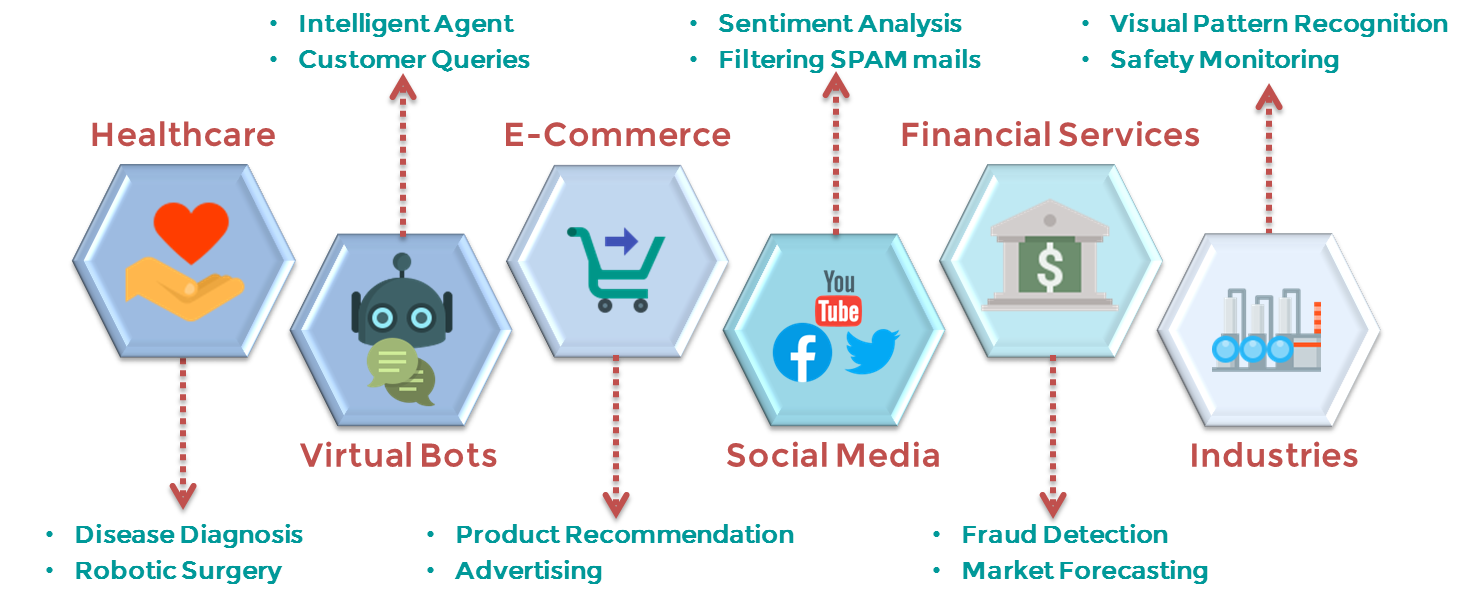
Application of Machine Learning
So to sum it up, machine learning has various use cases to make human life better.
You may also like
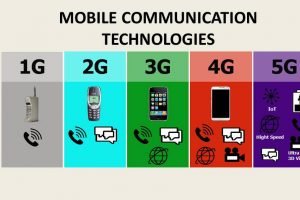
Mobile Telecommunication Technologies

Cloud Computing

